Build a Newsletter System With PHP and MySQL
Today, we are going to be building a newsletter system using PHP with a MySQL database. The tutorial will cover building a system that allows for multiple newsletter lists and the sending of messages to specific lists.
We are going to build a pretty complex newsletter system, so let's get started! You are going to need two resources for the project:
- The Silk Icon set library will be used to add some visual flair to the application.
- The Symfony PHP Mailer library will be used to send emails.
Create the Application Skeleton
Firstly, let's have a look at the overall project directory structure.
Go ahead and create a main project directory in the first place. Next, create a folder named admin within your project folder. Moving further, within the admin folder, include two sub-directories named media and swift. Additionally, create a new folder named images inside the media directory. It is recommended to position the Swift lib folder within the previously created swift folder. Moreover, make sure to copy the set of six silk icons that we will be using.
- bullet_green.png
- bullet_red.png
- Build a Newsletter System With PHP and MySQL.png
- email_go.png
- find.png
- page_edit.png
For the rest of the tutorial, we'll be mostly developing CRUD functionalities (create, read, update, and Build a Newsletter System With PHP and MySQL).
Application Configuration
To easily manage application configuration throughout the PHP code, let's create a global configuration file, which defines constants that can be used throughout the application. We'll name it admin/config.php.
<?php <br>session_start(); <br>require_once 'database.php';<br><br>$mini = false;<br>$nonav = false;<br><br>error_reporting(0);<br><br>define('DB_SERVER', 'localhost');<br>define('DB_USER', 'root');<br>define('DB_PASSWORD', ''); <br>define('DB_NAME', 'tutsplus_ns_demo');<br>define('FROM_EMAIL', 'no_reply@ohyeahemail.com');<br>define('FROM_NAME', 'oh yeah email!');<br><br>$db = new Database(DB_SERVER, DB_USER, DB_PASSWORD, DB_NAME);<br>As you can see, we've defined constants related to the database settings and email configuration. Make sure you change the above settings as per your environment. So that's it for creating the global configuration file. We've also included the database class file, which we'll implement in a moment.
The Database Class
In this section, we'll implement the __construct method, we are creating a $db_server, $db_password, and validateUser method handles user authentication. It takes a username and password as parameters and calls the true; otherwise, it returns loggedIn method checks if a user is logged in by checking the true if the user is logged in and query method executes the SQL query provided in the first argument. It prepares the query and executes it. Then, it retrieves the result metadata, binds the result to variables, fetches the results, and returns an array containing the fetched data. The updateQuery, and countQuery method executes an SQL query, which returns a single result, such as a count.
The head, POST request and if it includes both a username and password. In that case, we call the Database class. Subsequently, we've assigned the session errors to the users table, which we'll need in our database for the user management system.
<?php <br>session_start(); <br>require_once 'database.php';<br><br>$mini = false;<br>$nonav = false;<br><br>error_reporting(0);<br><br>define('DB_SERVER', 'localhost');<br>define('DB_USER', 'root');<br>define('DB_PASSWORD', ''); <br>define('DB_NAME', 'tutsplus_ns_demo');<br>define('FROM_EMAIL', 'no_reply@ohyeahemail.com');<br>define('FROM_NAME', 'oh yeah email!');<br><br>$db = new Database(DB_SERVER, DB_USER, DB_PASSWORD, DB_NAME);<br>Newsletters
In our application, users should be allowed to add as many newsletters as they want. In that case, we need to create the newsletters table in place, we are going to implement different pages for the newsletter management.
Newsletters Listing Page
Go ahead and create the admin/newsletters.php file, as shown in the following snippet.
CREATE TABLE `users` ( <br> `id` int(10) AUTO_INCREMENT, <br> `username` varchar(50), <br> `password` varchar(32), <br> PRIMARY KEY (`id`) <br>) ENGINE=MyISAM DEFAULT CHARSET utf8; <br><br><br>INSERT INTO `users` (`id`, `username`, `password`) VALUES ('1', 'admin', '5ebe2294ecd0e0f08eab7690d2a6ee69');<br>Firstly, it checks if the user is logged in by calling the Database class. If the user is not logged in, it redirects the user to the login.php page.
Next, it retrieves the list of newsletters from the database using the Database class. It selects all records from the id column in ascending order.
Finally, we iterate over the newsletter records and build an HTML table list, and include the layout.php file to display the newsletter listing.
With a few records already in the insertQuery method of the $_POST['name'] and newsletters table in the database. Finally, it redirects the user to the newsletters.php page.
The form should look like this.
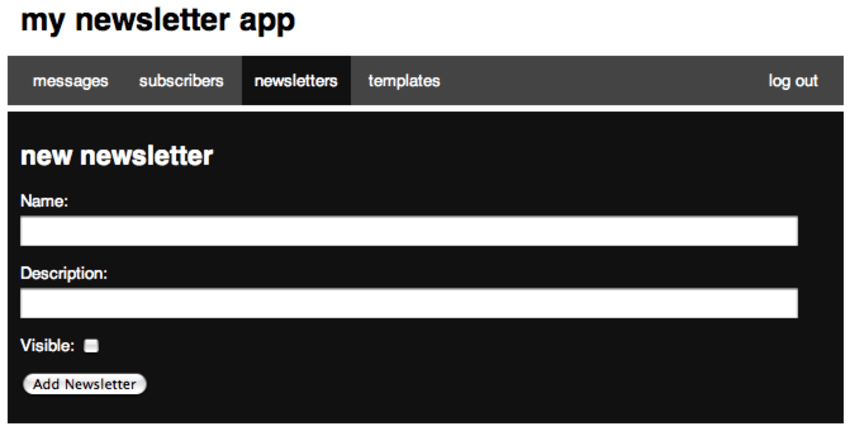
Edit a Newsletter
Let's create the admin/newsletters_edit.php file, which allows users to edit existing newsletters.
<?php <br>require_once 'config.php'; <br><br>$response = $db->loginRequired();<br>if (!$response) {<br> header('Location: login.php');<br> exit;<br>}<br>$title = "Newsletters"; <br>$newsletters = $db->query("SELECT * FROM newsletters ORDER BY id ASC");<br><br>$tab = 'nl'; <br>$table = ""; <br><br>foreach($newsletters as $row) {<br> $dlink = '<a href="newsletters_Build%20a%20Newsletter%20System%20With%20PHP%20and%20MySQL.php?id='.%24row%5B'id'%5D.'" onclick="return confirm(\'Are you sure you want to Build a Newsletter System With PHP and MySQL this newsletter?\');" title="Build a Newsletter System With PHP and MySQL"><img src="/static/imghw/default1.png" data-src="media/images/page_edit.png" class="lazy" alt="Build a Newsletter System With PHP and MySQL"></a>';<br> $elink = '<a href="newsletters_edit.php?id='.%24row%5B'id'%5D.'" title="edit"><img src="/static/imghw/default1.png" data-src="media/images/page_edit.png" class="lazy" alt="edit"></a>';<br> if($row['visible'] == "1") {<br> $visible = '<img src="/static/imghw/default1.png" data-src="media/images/bullet_green.png" class="lazy" alt="Build a Newsletter System With PHP and MySQL" >';} else {$visible = '<img src="/static/imghw/default1.png" data-src="media/images/bullet_red.png" class="lazy" alt="Build a Newsletter System With PHP and MySQL" >';<br> }<br> $table .= "<tr>
<td>".$row['id']."</td>
<td>".$row['name']."</td>
<td>".$row['description']."</td>
<td>$visible</td>
<td>".$dlink." ".$elink."</td>
</tr>\n";<br>} <br><br>$message = $db->errorMessages();<br>$content = '';<br>$content .= '<a href="newsletters_new.php">Add New Newsletter »</a> ';<br>$content .= $message;<br>$content .= '| name | description | visible |
|---|
include 'layout.php';
?>
Overall, it's responsible for displaying a form to edit an existing newsletter. When it's submitted, it updates the corresponding record in the database and redirects the user to the appropriate page based on the outcome.
The edit form looks like this.
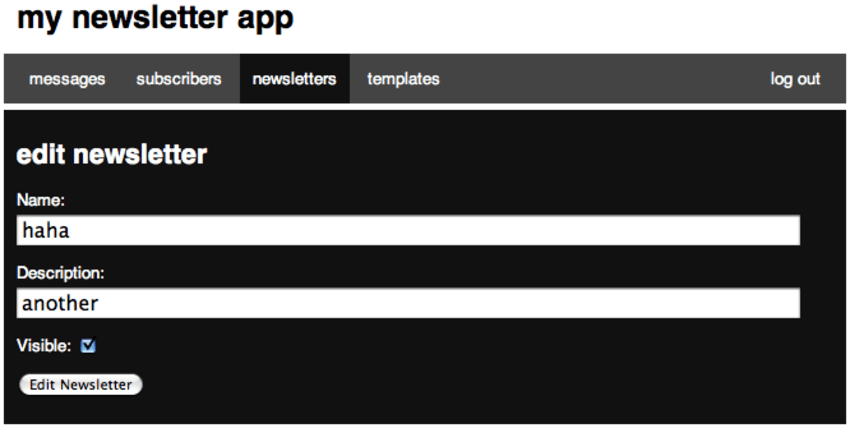

Delete a Newsletter
Go ahead and create the admin/newsletters_Build a Newsletter System With PHP and MySQL.php file, which allows users to Build a Newsletter System With PHP and MySQL an existing newsletter.
<?php <br>session_start(); <br>require_once 'database.php';<br><br>$mini = false;<br>$nonav = false;<br><br>error_reporting(0);<br><br>define('DB_SERVER', 'localhost');<br>define('DB_USER', 'root');<br>define('DB_PASSWORD', ''); <br>define('DB_NAME', 'tutsplus_ns_demo');<br>define('FROM_EMAIL', 'no_reply@ohyeahemail.com');<br>define('FROM_NAME', 'oh yeah email!');<br><br>$db = new Database(DB_SERVER, DB_USER, DB_PASSWORD, DB_NAME);<br>Templates
Our application also supports newsletter template management. So we need to build the CRUD in the same way we just built it for the newsletters entity. Since it's pretty similar, I'll quickly go through it by providing the code.
Let's create the subscribers table as shown in the following snippet.
CREATE TABLE `users` ( <br> `id` int(10) AUTO_INCREMENT, <br> `username` varchar(50), <br> `password` varchar(32), <br> PRIMARY KEY (`id`) <br>) ENGINE=MyISAM DEFAULT CHARSET utf8; <br><br><br>INSERT INTO `users` (`id`, `username`, `password`) VALUES ('1', 'admin', '5ebe2294ecd0e0f08eab7690d2a6ee69');<br>Similarly, let's create the subscribers table. Next, we'll either create or Build a Newsletter System With PHP and MySQL the subscription record in the messages table with this SQL.
<?php <br>require_once 'config.php'; <br><br>$response = $db->loginRequired();<br>if (!$response) {<br> header('Location: login.php');<br> exit;<br>}<br>$title = "Newsletters"; <br>$newsletters = $db->query("SELECT * FROM newsletters ORDER BY id ASC");<br><br>$tab = 'nl'; <br>$table = ""; <br><br>foreach($newsletters as $row) {<br> $dlink = '<a href="newsletters_Build%20a%20Newsletter%20System%20With%20PHP%20and%20MySQL.php?id='.%24row%5B'id'%5D.'" onclick="return confirm(\'Are you sure you want to Build a Newsletter System With PHP and MySQL this newsletter?\');" title="Build a Newsletter System With PHP and MySQL"><img src="/static/imghw/default1.png" data-src="media/images/page_edit.png" class="lazy" alt="Build a Newsletter System With PHP and MySQL"></a>';<br> $elink = '<a href="newsletters_edit.php?id='.%24row%5B'id'%5D.'" title="edit"><img src="/static/imghw/default1.png" data-src="media/images/page_edit.png" class="lazy" alt="edit"></a>';<br> if($row['visible'] == "1") {<br> $visible = '<img src="/static/imghw/default1.png" data-src="media/images/bullet_green.png" class="lazy" alt="Build a Newsletter System With PHP and MySQL" >';} else {$visible = '<img src="/static/imghw/default1.png" data-src="media/images/bullet_red.png" class="lazy" alt="Build a Newsletter System With PHP and MySQL" >';<br> }<br> $table .= "<tr>
<td>".$row['id']."</td>
<td>".$row['name']."</td>
<td>".$row['description']."</td>
<td>$visible</td>
<td>".$dlink." ".$elink."</td>
</tr>\n";<br>} <br><br>$message = $db->errorMessages();<br>$content = '';<br>$content .= '<a href="newsletters_new.php">Add New Newsletter »</a> ';<br>$content .= $message;<br>$content .= '| name | description | visible |
|---|
include 'layout.php';
?>
List Messages
Go ahead and create the admin/messages.php file as shown in the following snippet.
<?php <br>require_once 'config.php'; <br><br>$response = $db->loginRequired();<br>if (!$response) {<br> header('Location: login.php');<br> exit;<br>}<br><br>$tab = 'nl';<br><br>if(isset($_POST['submitted'])) { <br> if(isset($_POST['visible'])) {$visible = 1;}else{$visible = 0;}<br> $data = array('name'=>$_POST['name'],'description'=>$_POST['description'], 'visible'=>$visible);<br> $db->updateQuery($data, $_POST['id'], 'newsletters');<br> $_SESSION['success'] = "Updated newsletter.";<br> header('Location: newsletters.php');<br> exit;<br>} <br><br>$title = "Edit newsletter";<br>$id = (int) $_GET['id'];<br><br>$results = $db->query("SELECT * FROM newsletters WHERE id='".$id."' LIMIT 1");<br>$name = $results[0]['name'];<br>$description = $results[0]['description'];<br>$visible = ($results[0]['visible'] == "1") ? 'checked="checked"' : '';<br><br>$content = 'include 'layout.php';
?>
It's a listing page with a few additional links for different operations. Your page should look like this:
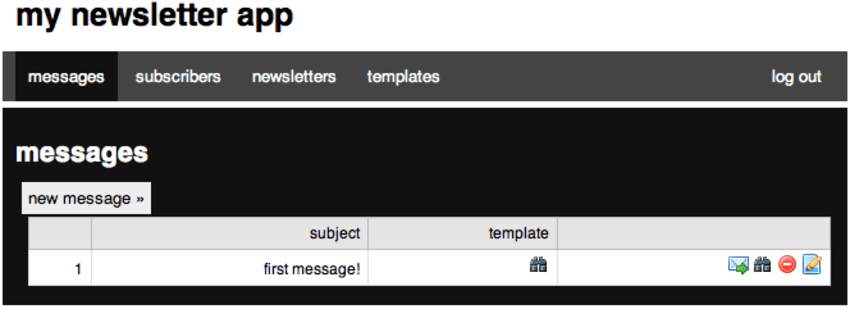
Now, we are going to start working on our new pages.
On the first page, we'll collect the subject and template-related information, and then on the next page, we'll collect the actual message.
Create the admin/messages_new.php file with the following contents.
<?php <br>require_once 'config.php'; <br><br>$response = $db->loginRequired();<br>if (!$response) {<br> header('Location: login.php');<br> exit;<br>}<br><br>$id = (int) $_GET['id']; <br>$stmt = $db->Build a Newsletter System With PHP and MySQLQuery($id);<br>$_SESSION['success'] = "Newsletter Build a Newsletter System With PHP and MySQLd."; <br><br>header('Location: newsletters.php');<br>?><br>This page is very similar to the other new pages, but there is a minor addition. Right after we create a new message entry, we find the most recent insert id.
The page looks like this:
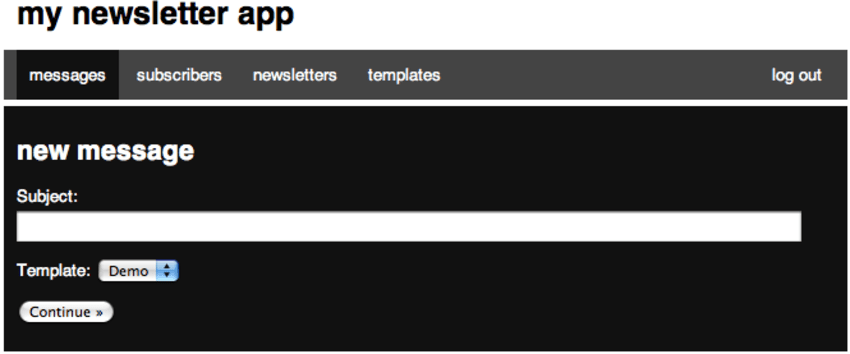
Next, we redirect the user to step two. Let's create the admin/messages_new_step2.php file with the following contents.
CREATE TABLE `subscribers` ( <br> `id` tinyint(10) AUTO_INCREMENT, <br> `name` varchar(50), <br> `email` varchar(50), <br> PRIMARY KEY (`id`) <br>) ENGINE=MyISAM DEFAULT CHARSET utf8;<br>
Firstly, we find the message we are working with, and then we find all the templates and construct a dropdown menu. Next, we have our subscribers table in the first place. Next, for every selected newsletter, we create an entry in the subscriptions<code>subscriptions table.

Next, let's create the preferences.php page.
CREATE TABLE `messages` ( <br> `id` tinyint(10) AUTO_INCREMENT, <br> `subject` varchar(255), <br> `leftcol` text, <br> `rightcol` text, <br> `template_id` tinyint(10), <br> PRIMARY KEY (`id`) <br>) ENGINE=MyISAM DEFAULT CHARSET utf8;<br>
It's used to allow users to save their newsletter preferences.
Firstly, when the form loads, it looks like this.

When you click on the Find button, it takes the user to the next page.

Finally, once a user clicks on the Save my preferences button, it displays the page shown in the following image.
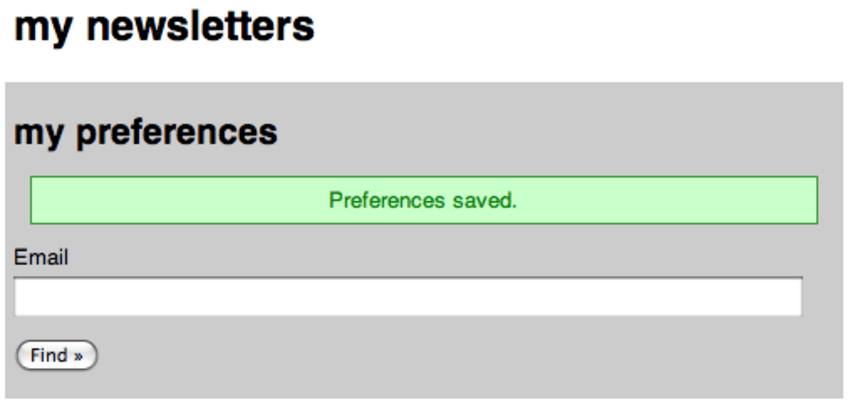
Sending Messages
In this section, we'll build the last page, which allows us to send messages.
Let's create the admin/messages_send.php file as shown in the following snippet.
<?php <br>session_start(); <br>require_once 'database.php';<br><br>$mini = false;<br>$nonav = false;<br><br>error_reporting(0);<br><br>define('DB_SERVER', 'localhost');<br>define('DB_USER', 'root');<br>define('DB_PASSWORD', ''); <br>define('DB_NAME', 'tutsplus_ns_demo');<br>define('FROM_EMAIL', 'no_reply@ohyeahemail.com');<br>define('FROM_NAME', 'oh yeah email!');<br><br>$db = new Database(DB_SERVER, DB_USER, DB_PASSWORD, DB_NAME);<br>It's used to build the form, which lists the newsletters in the first place. When an admin selects newsletters and submits the form, we retrieve the subscribers that are subscribed to these selected newsletters. And finally, we send an email to them.
It's also important to note that I've used the Symfony Mailer library to send emails. You can install it with Composer as shown in the following snippet. You need to adjust the settings as per your environment. To check more on this topic, you can visit this article, which provides an in-depth guide to the Symfony Mailer library.
CREATE TABLE `users` ( <br> `id` int(10) AUTO_INCREMENT, <br> `username` varchar(50), <br> `password` varchar(32), <br> PRIMARY KEY (`id`) <br>) ENGINE=MyISAM DEFAULT CHARSET utf8; <br><br><br>INSERT INTO `users` (`id`, `username`, `password`) VALUES ('1', 'admin', '5ebe2294ecd0e0f08eab7690d2a6ee69');<br>The form looks like this:
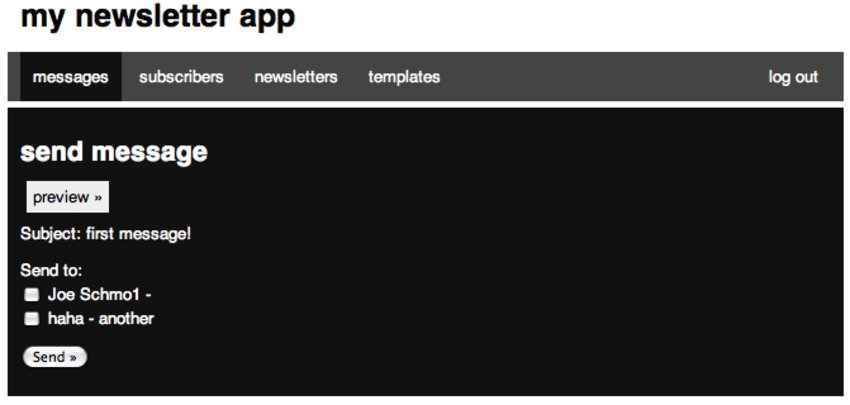
The Homepage
Now, let's build the admin home page, which displays overall statistics for our application.
Let's create the admin/index.php file with the following contents.
<?php <br>require_once 'config.php'; <br><br>$response = $db->loginRequired();<br>if (!$response) {<br> header('Location: login.php');<br> exit;<br>}<br>$title = "Newsletters"; <br>$newsletters = $db->query("SELECT * FROM newsletters ORDER BY id ASC");<br><br>$tab = 'nl'; <br>$table = ""; <br><br>foreach($newsletters as $row) {<br> $dlink = '<a href="newsletters_Build%20a%20Newsletter%20System%20With%20PHP%20and%20MySQL.php?id='.%24row%5B'id'%5D.'" onclick="return confirm(\'Are you sure you want to Build a Newsletter System With PHP and MySQL this newsletter?\');" title="Build a Newsletter System With PHP and MySQL"><img src="/static/imghw/default1.png" data-src="media/images/page_edit.png" class="lazy" alt="Build a Newsletter System With PHP and MySQL"></a>';<br> $elink = '<a href="newsletters_edit.php?id='.%24row%5B'id'%5D.'" title="edit"><img src="/static/imghw/default1.png" data-src="media/images/page_edit.png" class="lazy" alt="edit"></a>';<br> if($row['visible'] == "1") {<br> $visible = '<img src="/static/imghw/default1.png" data-src="media/images/bullet_green.png" class="lazy" alt="Build a Newsletter System With PHP and MySQL" >';} else {$visible = '<img src="/static/imghw/default1.png" data-src="media/images/bullet_red.png" class="lazy" alt="Build a Newsletter System With PHP and MySQL" >';<br> }<br> $table .= "<tr>
<td>".$row['id']."</td>
<td>".$row['name']."</td>
<td>".$row['description']."</td>
<td>$visible</td>
<td>".$dlink." ".$elink."</td>
</tr>\n";<br>} <br><br>$message = $db->errorMessages();<br>$content = '';<br>$content .= '<a href="newsletters_new.php">Add New Newsletter »</a> ';<br>$content .= $message;<br>$content .= '| name | description | visible |
|---|
include 'layout.php';
?>
And it looks like this:
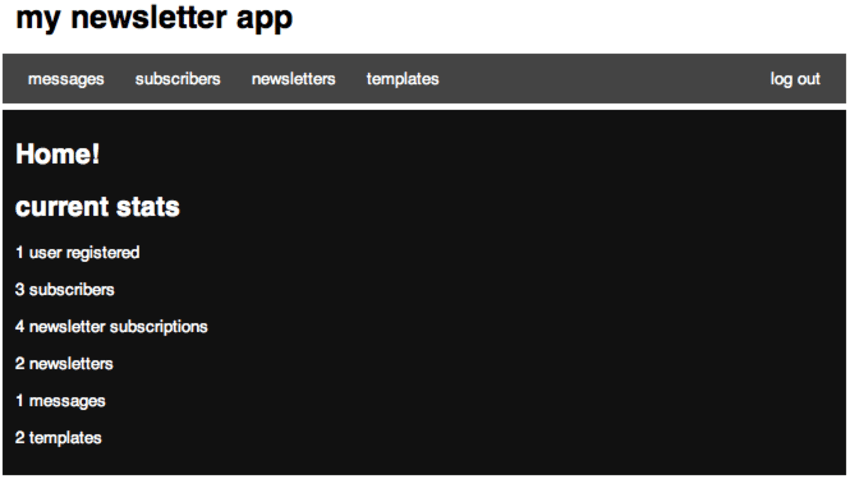
Conclusion
And with that, we've reached the end of this article as well. We covered a lot of ground in the tutorial, creating a newsletter app completely from scratch!
The above is the detailed content of Build a Newsletter System With PHP and MySQL. For more information, please follow other related articles on the PHP Chinese website!

Hot AI Tools

Undresser.AI Undress
AI-powered app for creating realistic nude photos

AI Clothes Remover
Online AI tool for removing clothes from photos.

Undress AI Tool
Undress images for free

Clothoff.io
AI clothes remover

Video Face Swap
Swap faces in any video effortlessly with our completely free AI face swap tool!

Hot Article

Hot Tools

Notepad++7.3.1
Easy-to-use and free code editor

SublimeText3 Chinese version
Chinese version, very easy to use

Zend Studio 13.0.1
Powerful PHP integrated development environment

Dreamweaver CS6
Visual web development tools

SublimeText3 Mac version
God-level code editing software (SublimeText3)

Hot Topics
 1666
1666
 14
14
 1425
1425
 52
52
 1325
1325
 25
25
 1272
1272
 29
29
 1252
1252
 24
24
 Explain secure password hashing in PHP (e.g., password_hash, password_verify). Why not use MD5 or SHA1?
Apr 17, 2025 am 12:06 AM
Explain secure password hashing in PHP (e.g., password_hash, password_verify). Why not use MD5 or SHA1?
Apr 17, 2025 am 12:06 AM
In PHP, password_hash and password_verify functions should be used to implement secure password hashing, and MD5 or SHA1 should not be used. 1) password_hash generates a hash containing salt values to enhance security. 2) Password_verify verify password and ensure security by comparing hash values. 3) MD5 and SHA1 are vulnerable and lack salt values, and are not suitable for modern password security.
 PHP and Python: Comparing Two Popular Programming Languages
Apr 14, 2025 am 12:13 AM
PHP and Python: Comparing Two Popular Programming Languages
Apr 14, 2025 am 12:13 AM
PHP and Python each have their own advantages, and choose according to project requirements. 1.PHP is suitable for web development, especially for rapid development and maintenance of websites. 2. Python is suitable for data science, machine learning and artificial intelligence, with concise syntax and suitable for beginners.
 PHP in Action: Real-World Examples and Applications
Apr 14, 2025 am 12:19 AM
PHP in Action: Real-World Examples and Applications
Apr 14, 2025 am 12:19 AM
PHP is widely used in e-commerce, content management systems and API development. 1) E-commerce: used for shopping cart function and payment processing. 2) Content management system: used for dynamic content generation and user management. 3) API development: used for RESTful API development and API security. Through performance optimization and best practices, the efficiency and maintainability of PHP applications are improved.
 PHP: A Key Language for Web Development
Apr 13, 2025 am 12:08 AM
PHP: A Key Language for Web Development
Apr 13, 2025 am 12:08 AM
PHP is a scripting language widely used on the server side, especially suitable for web development. 1.PHP can embed HTML, process HTTP requests and responses, and supports a variety of databases. 2.PHP is used to generate dynamic web content, process form data, access databases, etc., with strong community support and open source resources. 3. PHP is an interpreted language, and the execution process includes lexical analysis, grammatical analysis, compilation and execution. 4.PHP can be combined with MySQL for advanced applications such as user registration systems. 5. When debugging PHP, you can use functions such as error_reporting() and var_dump(). 6. Optimize PHP code to use caching mechanisms, optimize database queries and use built-in functions. 7
 How does PHP type hinting work, including scalar types, return types, union types, and nullable types?
Apr 17, 2025 am 12:25 AM
How does PHP type hinting work, including scalar types, return types, union types, and nullable types?
Apr 17, 2025 am 12:25 AM
PHP type prompts to improve code quality and readability. 1) Scalar type tips: Since PHP7.0, basic data types are allowed to be specified in function parameters, such as int, float, etc. 2) Return type prompt: Ensure the consistency of the function return value type. 3) Union type prompt: Since PHP8.0, multiple types are allowed to be specified in function parameters or return values. 4) Nullable type prompt: Allows to include null values and handle functions that may return null values.
 The Enduring Relevance of PHP: Is It Still Alive?
Apr 14, 2025 am 12:12 AM
The Enduring Relevance of PHP: Is It Still Alive?
Apr 14, 2025 am 12:12 AM
PHP is still dynamic and still occupies an important position in the field of modern programming. 1) PHP's simplicity and powerful community support make it widely used in web development; 2) Its flexibility and stability make it outstanding in handling web forms, database operations and file processing; 3) PHP is constantly evolving and optimizing, suitable for beginners and experienced developers.
 PHP vs. Other Languages: A Comparison
Apr 13, 2025 am 12:19 AM
PHP vs. Other Languages: A Comparison
Apr 13, 2025 am 12:19 AM
PHP is suitable for web development, especially in rapid development and processing dynamic content, but is not good at data science and enterprise-level applications. Compared with Python, PHP has more advantages in web development, but is not as good as Python in the field of data science; compared with Java, PHP performs worse in enterprise-level applications, but is more flexible in web development; compared with JavaScript, PHP is more concise in back-end development, but is not as good as JavaScript in front-end development.
 PHP and Python: Code Examples and Comparison
Apr 15, 2025 am 12:07 AM
PHP and Python: Code Examples and Comparison
Apr 15, 2025 am 12:07 AM
PHP and Python have their own advantages and disadvantages, and the choice depends on project needs and personal preferences. 1.PHP is suitable for rapid development and maintenance of large-scale web applications. 2. Python dominates the field of data science and machine learning.




